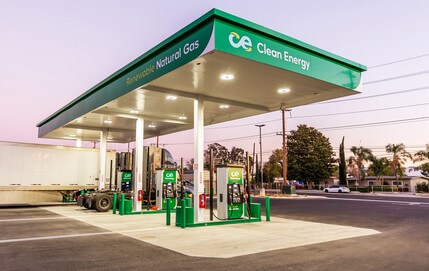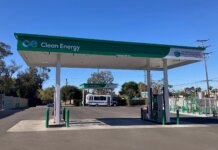Clean Energy Fuels Corp. has significantly increased its renewable natural gas (RNG) fueling footprint in Southern California with the opening of two additional stations in San Bernadino and Perris.
Strategically located near warehouse hubs and key commercial transportation corridors, these stations open at a pivotal time in the heavy-duty trucking industry as fleets seek solutions to reduce carbon emissions and decarbonize operations.
Besides Clean Energy’s expanding fueling infrastructure nationwide, Cummins recently introduced its X15N engine, the first 15-liter engine powered by RNG to hit the market. The Cummins X15N has been road-tested by UPS, Walmart, Knight Swift and other heavy-duty truck fleets to positive reviews. The new engine, which has similar power and torque to its diesel counterpart, can reduce carbon emissions by over 300% and nitrogen oxide (NOx) emissions by 90%.
“These station openings come at an opportune time as the demand for RNG continues to grow now that the highly anticipated Cummins’ X15N is available,” says Chad Lindholm, senior vice president at Clean Energy. “There’s a growing realization that the other much-hyped technologies aren’t living up to their promises of availability, fueling infrastructure or cost of ownership. The RNG solution is here and now, providing fleets with incredible emissions reductions affordably. Clean Energy now has an even more accessible and reliable fueling network from the Ports of Long Beach and LA to the Inland Empire.”
The San Bernadino station, located at 1110 East Central Avenue, covers 6.4 acres near the 215 and Interstate 10 freeways, and includes four fast-fill lanes for easy in-and-out fueling. The address of the Perris station is 19295 Harvill Avenue, conveniently located off the 215 freeway. Equipped with two fast-fill lanes, the site covers three acres.
Clean Energy operates over 600 stations across the U.S. and Canada, 200 of which have tractor-trailer access.
The company is also investing hundreds of millions of dollars in the production of RNG at dairy farms in the U.S. to ensure a steady supply or low-carbon RNG. Agriculture accounts for nearly 10% of U.S. GHG emissions, and the transportation sector accounts for another 28%, according to the U.S. Environmental Protection Agency.
Capturing methane from farm waste lowers these emissions. RNG, produced by that captured methane and used as a transportation fuel, significantly lowers GHG emissions on a lifecycle basis compared with diesel. This allows RNG to be one of the only transportation fuels to receive a negative carbon-intensity score based on the reduction of emissions at the source and at the vehicle.







